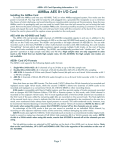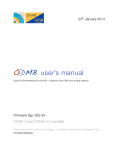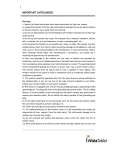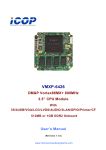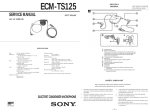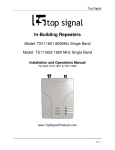Download MSI-P442 Rev.0 USER MANUAL - Microcomputer Systems, Inc.
Transcript
MSI-P442 Rev.0 12-CHANNEL THERMOCOUPLE & 12-BIT 4-CHANNEL A/D & 1-CHANNEL D/A CARD USER MANUAL PC/104 Embedded Industrial Analog I/O Series Microcomputer Systems, Inc. 1814 Ryder Drive Baton Rouge, LA 70808 Ph (225) 769-2154 Fax (225) 769-2155 Email: [email protected] http://www.microcomputersystems.com Page MSI-P442 User Manual CONTENTS I. INTRODUCTION 3 II. HARDWARE DESCRIPTION 5 A. Card Configuration B. Card Addressing C. MAX197 A/D Converters for Thermocouple and Analog Inputs D. Interrupt Connections for Thermocouple and Analog Inputs E. Obtaining a Temperature Reference for the Card F. AD5341 D/A Converter for Analog Output G. Connecting Inputs and Output to J1 III. PROGRAMMING 9 A. Programming the MAX197 for Thermocouple and Analog Inputs B. Programming the AD5341 for Analog Output IV. Temperature vs Thermocouple Input Voltage (Channels 0 thru 11) 16 V. SPECIFICATIONS 18 APPENDIX 19 Circuit Diagrams and Data Sheets Page MSI-P442 User Manual I. INTRODUCTION The MSI-P442 is a low cost, high performance card that provides twelve K-type thermocouple inputs, four 12-bit analog inputs and one 12-bit analog output designed for use with all PC/104 embedded systems. Several models permit different combinations of these functions. Software programmable analog input ranges are 0-5V, 0-10V, ±5V and ±10V with a linearity of 1/2 LSB. The analog output range is 0-5V. A block diagram of the card is shown in Figure 1. The thermocouple inputs are conditioned by Analog Devices AD597 devices which provide built-in ice point compensation with temperature proportional operation of 10 mV/°C in the temperature range of -200°C to 1000°C. The analog inputs are single-ended with an input impedance of 1MOhms. The analog output is provided by an Analog Devices AD5341 IC. The card employs two Maxim MAX197 eight-channel A/D converters that provide inputs for the thermocouples (12 channels) and analog inputs (4 channels). Each incorporates a precision 2.5V reference source with buffer amp, an internal 1.56 MHz clock, and successive approximation and internal input track/hold circuitry to convert the analog signal of each PC/104 BUS INTERFACE NETWORK PC/104 BUS INTERRUPT NETWORK INTERRUPT JUMPERS AD597 THERMOCOUPLE CONDITIONERS 34-PIN I/O CONNECTOR PC/104 8-BIT STACKTHROUGH CONNECTOR A4-A15 JUMPERS Two MAX197 (CH 0-15) INPUT BUFFER AMPLIFIERS FOR ANALOG IN 1 - 4 AD5341 D/A CONVERTER MSI-P442 Figure 1. Block Diagram of the MSI-P442. Page 3 MSI-P442 User Manual channel into a 12-bit digital signal. Low span and offset errors result in no adjustments being required for these functions. Typical total conversion times of 12 us gives a sample rate of 83 ksps for each group times of 12 us gives a sample rate of 83 ksps for each group of eight channels yielding rates up to 166 ksps for 16 input channels. An Analog Devices AD5341 provides the 12-bit 0-5V analog output signal. The 2.5V reference voltage is supplied from one of the MAX197 devices. The card is I/O mapped using 16-bit addressing to select the input channels and device status. Option jumpers are provided by JP1 for specifying the card address (A4 - A15) and interrupt processing is provided for IRQ4 thru IRQ7 and IRQ9 using options jumpers, as described in the next section. Page 4 MSI-P442 User Manual II. HARDWARE DESCRIPTION A. Card Configuration The MSI-P442 card is a CMOS design using through-hole and surface-mounted devices. The card configuration is shown in Figure 2 and a circuit diagram of the network is given in the Appendix. Connector J1 provides connections of the thermocouple input signals T/C 1 thru T/C 12, for ANALOG IN 1 thru ANALOG IN 4 input voltages, and the ANALOG OUTPUT voltage. Jumper block JP1 is used for address selection (Pins 1 thru 24) and interrupt configuration (Pins 25 thru 34), as described below. Figure 2. MSI-P442 card outline. Page 5 MSI-P442 User Manual B. Card Addressing The card address is set by installing appropriate jumpers on JP1, pins 1 thru 24, as shown in Fig. 3. An uninstalled jumper for a given address bit sets the bit to 0 (false) and an installed jumper sets the bit equal to 1 (true). Addresses A4 thru A15 are jumper selectable for defining the base address of the card from 0000H to FFF0H on integral 10H boundaries, where H denotes a hexadecimal number. To assign a base address of 3040H, for example, install jumpers JP1-A13, JP1-A12, and JP1-A6. Pins 25 thru 34 are used to configure the interrupt connections, if interrupts are used, as described in the Section II.D. C. MAX197 A/D Converters for Thermocouple and Analog Inputs. 1KOHM o o o o o o o o o o o o o 33 o IRQ4 34 INT OUT o 31 o IRQ5 32 INT OUT o 29 o IRQ6 30 INT OUT 28 INT OUT 26 o 27 o 25 o IRQ7 o IRQ9(2) 24 o 23 A4 22 o 21 A5 20 o 19 A6 18 o 17 A7 16 o 15 A8 14 o 13 A9 12 o 11 A10 10 o 9 A11 8 o 7 A12 6 o 5 A13 4 o 3 A14 2 o 1 A15 The MAX197 converters each have two registers for performing data conversions, a control output register (C) and an input data register (I). A third register implemented on the card for denoting interrupt status is called the status register (S). The addresses of the control, input data (C/I) and status for each channel are given in Table 1. The functions of the control, the input data (hi and lo bytes), Figure 3. Jumper block JP1 configuration for base address and interrupt selection. Page 6 MSI-P442 User Manual and status registers are described in the Section III. Table 1. MAX197 Analog Converters Control Register Addresses. Channels Control Output (C) Data Input (I) Status (S) / Bit 0-7 base+0 base+0 (lo) base+1 (hi) base+4 / 0 8-15 base+2 base+2 (lo) base+3 (hi) base+4 / 1 D. Interrupt Connections for Thermocouple and Analog Inputs. (See Note 1 on Page 7A) Interrupt connections are implemented by pins 25 thru 34 of JP1. The steps in the procedure are as follows. 1) Pins JP1-26, JP1-28, JP1-30 and JP1-32 (INT OUT) are connected and have the composite interrupt signal from the analog converters (see circuit diagram in Appendix). Any one of these can be jumpered to a single desired interrupt, IRQ4 thru IRQ9, of JP1 shown in Fig. 3. This connection causes the interrupt selected to be activated when an end-of-conversion occurs from either analog converter. The interrupt status can be checked to determine which converter interrupt is active, as described in Section III. 2) Pin JP1-32 (1 KOhm pull-down resistor) is used to properly terminate the interrupt line selected in step 1. This pin should be jumpered to the interrupt line selected for only one card in the system. E. Obtaining a Temperature Reference for the Card. A temperature reference can be obtained by shorting one of the thermocouple inputs at J1. The resulting measurement for this input is the temperature of the AD597 of this channel. F. AD5341 D/A Converter for Analog Output. An AD5341 provides a 12-bit, 0-5V output voltage. The device contains a 12-bit output data register (O) and an output data latch (L). The addresses of the output data register (hi and lo bytes), and the output data latch are given in Table 2. The Page 7 MSI-P442 User Manual NOTE 1 A. IRQ9 IS MIS-LABELLED AS IRQ4 ON MSI-P442 Rev. 0. B. IRQ7 IS MIS-LABELLED AS IRQ5 ON MSI-P442 Rev. 0. C. IRQ5 IS MIS-LABELLED AS IRQ7 ON MSI-P442 Rev. 0. Page 7A MSI-P442 User Manual operations of these registers are described in Section III. Table 2. AD5341 Output Data, Latch, and Clear Addresses. Output Data Register(O) Output Data Latch (L) base+6 (lo) base+7 (hi) base+8 G. Connecting Inputs and Output to J1. Thermocouple inputs, analog inputs and the analog output are interconnected to the card via J1 using a 34-pin flat cable connector. Pin assignments are given in Table 3. Table 3. Connector J1 Inputs and Output. Input J1 Pin Input J1 Pin T/C 1+ T/C 1 - 1 2 T/C 10+ T/C 10 - 19 20 T/C 2+ T/C 2 - 3 4 T/C 11+ T/C 11 - 21 22 T/C 3+ T/C 3 - 5 6 T/C 12+ T/C 12 - 23 24 T/C 4+ T/C 4 - 7 8 ANALOG IN 1 GND 25 26 T/C 5+ T/C 5 - 9 10 ANALOG IN 2 GND 27 28 T/C 6+ T/C 6 - 11 12 ANALOG IN 3 GND 29 30 T/C 7+ T/C 7 - 13 14 ANALOG IN 4 GND 31 32 T/C 8+ T/C 8 - 15 16 ANALOG OUT* GND 33 34 T/C 9+ T/C 9 - 17 18 * Optional connector J2 (Molex 705530001) also provides ANALOG OUT. Page 8 MSI-P442 User Manual III. PROGRAMMING A. Programming the MAX197 for Thermocouple and Analog Inputs. Performing data conversions involves a write operation to the control register of the appropriate MAX197, which selects the mux channel and configures the input mode. The data is then read, lo byte and hi byte, when the conversion has been completed. 1. Control Register Format The control register is an 8-bit (write-only) register that selects the mux channel and mode of the converter. The format is D7(MSB) PD1 D6 D5 PD0 ACQMOD D4 RNG D3 BIP D2 A2 D1 A1 D0(LSB) A0 where PD1, PD0 select the clock and power down mode (Table 4). ACQMOD - 0 = internally controlled acquisition, 1 = externally controlled acquisition. RNG selects the full-scale voltage range (Table 5). BIP selects unipolar or bipolar conversion mode (Table 5). A2, A1, A0 select the desired input channel 0-7 of the MAX197. The card is designed to operate using the internal clock with PD1 = 0 and PD0 = 1 in normal operation. The internally controlled acquisition (ACQMOD = 0) is normally used . PD1 0 0 1 1 PD0 0 1 0 1 Page 9 Table 4. Clock and Power Down Selection DEVICE MODE Normal Operation/External Clock Mode Normal Operation/Internal Clock Mode Standby Power-down (STBYPD); clock unaffected Full Power-down (FULLPD); clock unaffected MSI-P442 User Manual Table 5. Range and Polarity Selection BIP RNG INPUT RANGE (V) 0 0 0 to 5 0 1 0 to 10 1 0 ±5 1 1 ±10 2. Performing a Conversion Conversions are initiated with a write operation to the control register (Table 1), which selects the mux channel of the desired MAX197 (U9, Channel 0-7 or U5, Channel 8-15) and configures the device mode. Selecting ACQMOD = 0 in the control register selects the internal acquisition mode. This causes the write to the control register to initiate the acquisition interval whose duration is internally timed. Conversion starts when this six-clock-cycle acquisition interval ends. Writing a new control byte during the conversion cycle will abort the conversion and start a new acquisition interval. 3. Reading the Data Register Conversions are complete when the appropriate status bit (Table 1) becomes 0 following a write to the control register. Channels 0-7 (U9) are ready when bit 0 at address base+4 is 0. The data can now be read at the appropriate lo and hi byte addresses for the lo and hi bytes of the channel selected (A2, A1, A0 of the control register). Channels 0-7, addresses base+0 and base+1, respectively, are read. Channels 8-15 (U5) are ready when bit 1 at address base+4 is 0. The data can now be read at the appropriate lo and hi byte addresses for the lo and hi bytes of the channel selected (A2, A1, A0 of the control register). Channels 8-15 addresses base+2 and base+3, respectively, are read. 4. Input Data Format Unipolar Mode - the output data format is binary. In this Page 10 MSI-P442 User Manual case, 0 volts input yields 000H, where H denotes a hexadecimal number. The value increases linearly from 000H to FFFH with increasing input voltage. A +FS input (full-scale +5V or +10V ranges) gives FFFH. Bipolar Mode - the output data format is twos-complement binary. In this case, a -FS input (±5V or ±10V ranges) yields 800H. The value increases linearly from 800H toward FFFH as the input voltage changes from -FS toward 0 volts. At 0 volts input (in the ideal case), the value is 000H. Again, the value increases linearly from 000H toward 7FFH as the input voltage changes from 0 toward +FS volts. The lo byte read, bits D0 thru D7, of the input data is the low byte B0 thru B7 of the conversion result. The hi byte read of the input data contains bits B8 thru B11 of the conversion result in bits D0 thru D3. Bits D4 thru D7 contain all 0's and all 1's, respectively, for the unipolar and bipolar modes. 5. Power-Down Modes To save power, the converters can be placed into a lowpower shutdown mode between conversions. Two programmable power-down modes are available. Select STDBYPD or FULLPD by programming PD0 and PD1 in the control register. When software power-down is asserted, it becomes effective only after the end of conversion. In both power-down modes, the interface remains active and conversion results may be read. Input overvoltage protection is active. The converter returns to normal operation on the first write to the control register. In STDBYPD each device typically consumes 700uA and in FULLPD 120 uA maximum. The converter voltage reference remains active in STDBYPD. This is a DC power state that does not degrade after powerdown of any duration and any sampling rate can be used without regard to start-up delays. In FULLPD, however, start-up delays will effect the conversion. It is recommended when using this mode that a STDBYPD power-down cycle be performed prior to starting conversions to allow the Page 11 MSI-P442 User Manual 6. Example BASIC Programs for MAX197 A/D converters. Program 1 - A simple BASIC program that continually inputs thermocouple (channels 0 thru 12) for the 5V unipolar mode and lists the results to the console is given below. BASEADDR=&H8000 ‘ insert jumper A15 of JP1 CBYTE = &H40 ‘ Control Byte for 5V Unipolar Mode again: FOR I = 0 TO 7 ‘ process channels 0 - 7 OUT BASEADDR, CBYTE + I ‘ Write Control Byte WHILE (INP(BASEADDR + 4) AND 1) = 1: WEND ‘Test Status Bit 0 X = INP(BASEADDR) ‘ Read LO Byte Y = INP(BASEADDR + 1) ‘ Read HI Byte X = X + 256*(Y AND &HF) ‘ Mask off 4 MSB's of HI Byte ‘ Print CH 0 - CH 3, Linefeed, CH 4 - CH 7 in hexadecimal format IF I = 3 OR I = 7 THEN PRINT HEX$(X) ELSE PRINT HEX$(X), NEXT I FOR I = 0 TO 3 ‘ process channels 8 - 11 OUT BASEADDR+2, CBYTE + I ‘ Write Control Byte WHILE (INP(BASEADDR + 4) AND 2) = 2: WEND ‘Test Status Bit 1 X = INP(BASEADDR + 2) ‘ Read LO Byte Y = INP(BASEADDR + 3) ‘ Read HI Byte X = X + 256*(Y AND &HF) ‘ Mask off 4 MSB's of HI Byte ‘ Print CH 8 - CH 11 in hexadecimal format IF I = 3 THEN PRINT HEX$(X) ELSE PRINT HEX$(X), NEXT I PRINT “ ” GOTO again ‘Go Again END Program 2 - A simple BASIC program that reads the analog inputs (channels 12 thru 15) for unipolar and bipolar modes and lists the results to the console is given below. BASEADDR=&H300 ‘ insert jumpers A8 and A9 of JP1. ‘ Control Byte for 5V Unipolar Mode for Ch 12 OUT BASEADDR+2, &H44 ‘ Write Control Byte WHILE (INP(BASEADDR + 4) AND 2) = 2: WEND ‘Test Status Bit 1 X = INP(BASEADDR + 2) ‘ Read LO Byte Y = INP(BASEADDR + 3) ‘ Read HI Byte X = X + 256*(Y AND &HF) ‘ Mask off 4 MSB's of HI Byte PRINT “CH 12 = “; PRINT HEX$(X) ‘ Control Byte for 10V Unipolar Mode for Ch 13 OUT BASEADDR+2, &H55 ‘ Write Control Byte WHILE (INP(BASEADDR + 4) AND 2) = 2: WEND ‘Test Status Bit 1 X = INP(BASEADDR + 2) ‘ Read LO Byte Page 12 MSI-P442 User Manual Y = INP(BASEADDR + 3) ‘ Read HI Byte X = X + 256*(Y AND &HF) ‘ Mask off 4 MSB's of HI Byte PRINT “CH 13 = “; PRINT HEX$(X) ‘ Control Byte for +/-5V Bipolar Mode for Ch 14 OUT BASEADDR+2, &H4E ‘ Write Control Byte WHILE (INP(BASEADDR + 4) AND 2) = 2: WEND ‘Test Status Bit 1 X = INP(BASEADDR + 2) ‘ Read LO Byte Y = INP(BASEADDR + 3) ‘ Read HI Byte X = X + 256*(Y AND &HF) ‘ Mask off 4 MSB's of HI Byte PRINT “CH 14 = “; PRINT HEX$(X) ‘ Control Byte for +/-10V Bipolar Mode for Ch 15 OUT BASEADDR+2, &H5F ‘ Write Control Byte WHILE (INP(BASEADDR + 4) AND 2) = 2: WEND ‘Test Status Bit 1 X = INP(BASEADDR + 2) ‘ Read LO Byte Y = INP(BASEADDR + 3) ‘ Read HI Byte X = X + 256*(Y AND &HF) ‘ Mask off 4 MSB's of HI Byte PRINT “CH 15 = “; PRINT HEX$(X) END 7. Example 'C' Program Sequence For a simple 'C' program illustration using software polling of the device status, consider a case with the following parameters and events. 1) A base address for the card of 8000H (insert jumper A15 of JP1). 2) Read A/D channel 3 (input to U9) in the +5V unipolar mode and store the result in CH_3_INPUT. 3) Read A/D channel 9 (input to U5) in the ±10V bipolar mode and store the result in CH_9_INPUT. A simple program sequence for this operation is /* Constant declarations */ #define base_address #define control_byte_5 #define control_byte_5B #define control_byte_10 #define control_byte_10B #define delay_count 0x8000 0x40 0x48 0x50 0x58 1000 /* card base address */ /* control byte for +5V range */ /* control byte for ±5V range */ /* control byte for +10V range */ /* control byte for ±10V range */ /* delay count for converter time-out */ /* Memory assignments */ int A_D_value, CH_3_INPUT, CH_9_INPUT; Page 13 MSI-P442 User Manual /* Routine to input A/D channel CHAN(0-15) for control byte C_BYTE and returns 0 on a converter time-out error. Stores converted value in A_D_value */ int input_A_D( int CHAN, int C_BYTE ) { int converter_error, a, i, ch_group; if( 0 <= CHAN && CHAN < 8 ) ch_group = 0; else if( 7 < CHAN && CHAN < 16 ) {ch_group = 2; CHAN = CHAN - 8;} outp( base_address + ch_group, C_BYTE + CHAN ); //write control byte if( ch_group < 1 ) a = 1; //Ch 0-7 else a = 2; //Ch 8-15 i=0; do ++i; while ( (inp(base_address + 8) & a) && i < delay_count ); if( i == delay_count ) converter_error = 1;/* converter time-out error */ else converter_error = 0; A_D_value = inp( base_address + ch_group ); /* get converter value */ A_D_value = A_D_value + ((inp(base_address + ch_group + 1) & 0xf)<<8); return( converter_error ); } void main( void) { . . . /* Input channel 3 for +5V range and store if no time_out error */ if( !input_A_D( 3, control_byte_5 ) ) CH_3_INPUT = A_D_value;; /* Input channel 9 for ±10V range and store if no time_out error */ if( !input_A_D( 9, control_byte_10B) ) CH_9_INPUT = A_D_value;; . . . . } The function input_A_D( int CHAN, int C_BYTE ) above is written in general terms to permit calls from the main routine or from other user defined functions by simply using the appropriate CHAN and C_BYTE values for the input channel desired and the desired input range. Page 14 MSI-P442 User Manual B. Programming the AD5341 for Analog Output. Performing an analog output is performed by write operations to the AD5341 as described below. 1. Performing an Output Conversion. An voltage output is performed by loading the Output Data Register with the desired 12-bit value followed by a dummy write (output of any value) to the Output Data Latch to transfer the data to the output. The data register is loaded by performing byte writes to the lo byte and hi byte of the Output Data Register as given in Table 2. The data latch address is also in Table 2. 2. Output Data Format The 12-bit value of te data register gives an output that changes linearly from 0V for a value of 000H to 5V for a value of FFFH, where H denotes a hexadecimal number. Bits 0 thru 7 of the lo byte are bits 0 thru 7 of the data register. Bits 0 thru 3 of the hi byte are bits 8 thru 11 of the data register. Bits 4 thru 7 of the hi byte are ignored. The bit resolution for the output is 5V/4096 = 0.001221V or 1.221 mV/Bit 3. Power-on value of the AD5341 D/A converter. At power-on, the converter has an output value of 0. 4. Example BASIC Program for AD5341 D/A converter. Program 1 - A simple BASIC program that outputs a value entered from the keyboard to the converter. BASEADDR=&H3000 ‘ insert jumpers A12 and A13 of JP1 again: INPUT “Enter decimal value to output - “, X Y = X AND 255 ‘ get 8 bits of lo byte X = (X - Y)/256 AND 15 ‘ get 4 bits of hi byte OUT BASEADDR + 6, Y ‘ write lo byte OUT BASEADDR + 7, X ‘ write hi byte OUT BASEADDR + 8, 0 ‘ write output latch to transfer data GOTO again END Page 15 MSI-P442 User Manual IV. Temperature vs Thermocouple Input Voltage (Channels 0 thru 12) The temperature of a thermocouple input on any of channels 0 thru 7 is determined from the voltage that is read on its associated channel. In the case of a K type thermocouple, the voltage varies from -1446 mV to 10000 mV for temperatures of -200°C to 1000°C, respectively. Table 5 gives the temperature vs voltage outputs for both J type and K type thermocouples. In the case of both J type and K type thermocouples, the temperature is approximately given by Temperature °C ≈ 100 x (Vin in Volts) The appropriate converter span (0-5V, ±5V, 0-10V or ±10V) should to be chosen for the temperature range that is being monitored. Table I. Output Voltage vs. Thermocouple Temperature Thermocouple Temperature °C Type J Voltage mV AD596 Output mV Type K Voltage mV AD597 Output mV –200 –180 –160 –140 –120 –100 –80 –60 –40 –20 –10 0 10 20 25 30 40 50 60 80 100 120 140 160 180 –7.890 –7.402 –6.821 –6.159 –5.426 –4.632 –3.785 –2.892 –1.960 –.995 –.501 0 .507 1.019 1.277 1.536 2.058 2.585 3.115 4.186 5.268 6.359 7.457 8.560 9.667 –1370 –1282 –1177 –1058 –925 –782 –629 –468 –299 –125 –36 54 146 238 285 332 426 521 617 810 1006 1203 1401 1600 1800 –5.891 –5.550 –5.141 –4.669 –4.138 –3.553 –2.920 –2.243 –1.527 –.777 –.392 0 .397 .798 1.000 1.203 1.611 2.022 2.436 3.266 4.095 4.919 5.733 6.539 7.338 –1446 –1362 –1262 –1146 –1016 –872 –717 –551 –375 –191 –96 0 97 196 245 295 395 496 598 802 1005 1207 1407 1605 1801 Page 16 MSI-P442 User Manual Table I. Output Voltage vs. Thermocouple Temperature (Con’t.) Thermocouple Temperature Type J Voltage °C mV 200 220 240 260 280 300 320 340 360 380 400 420 440 460 480 500 520 540 560 580 600 620 640 660 680 700 720 740 750 760 780 800 820 840 860 880 900 920 940 960 980 1000 10.777 11.887 12.998 14.108 15.217 16.325 17.432 18.537 19.640 20.743 21.846 22.949 24.054 25.161 26.272 27.388 28.511 29.642 30.782 31.933 33.096 34.273 35.464 36.671 37.893 39.130 40.382 41.647 42.283 – – – – – – – – – – – – – Page 17 AD596 Output mV 2000 2201 2401 2602 2802 3002 3202 3402 3601 3800 3999 4198 4398 4598 4798 5000 5203 5407 5613 5821 6031 6243 6458 6676 6897 7120 7346 7575 7689 – – – – – – – – – – – – – Type K Voltage AD597 Output mV mV 8.137 8.938 9.745 10.560 11.381 12.207 13.039 13.874 14.712 15.552 16.395 17.241 18.088 18.938 19.788 20.640 21.493 22.346 23.198 24.050 24.902 25.751 26.599 27.445 28.288 29.128 29.965 30.799 31.214 31.629 32.455 33.277 34.095 34.909 35.718 36.524 37.325 38.122 38.915 39.703 40.488 41.269 1997 2194 2392 2592 2794 2996 3201 3406 3611 3817 4024 4232 4440 4649 4857 5066 5276 5485 5694 5903 6112 6321 6529 6737 6944 7150 7355 7560 7662 7764 7966 8168 8369 8569 8767 8965 9162 9357 9552 9745 9938 10130 MSI-P442 User Manual V. SPECIFICATIONS PC/104 16-bit, stackthrough Thermocouple and Analog Inputs T/C Channels 12 Analog Input 4 Converter MAXIM MAX197 Thermocouple I/F Analog Devices AD597 (K type) Analog Input Ranges 0-5V, 0-10V, ±5V, ±10V (Single-ended) Resolution 12 bits Conversion Rate 82 ksps per 8 channels Non-linearity ±1/2 LSB Offset Error < 0.5% of Span Gain Error < 0.5% of Span Signal-to-Noise 70 dB min Input Resistance 1 MOhms (Analog Input Channels) Internal Reference Ref Out Voltage 4.096 V ±1.5% max. Temp. Coeff. 40 ppm/°C Analog Output Analog Outputs 1 Converter Analog Devices AD5341 Resolution 12 bits Settling Time 10us Ref Voltage In 2.5V Connectors (Model No.) J1 (MSI-P442-K/I/O) One (1) 30334-5502 or eq. (34-pin) J1 (MSI-P440-K/I) One (1) 30334-5502 or eq. (34-pin) J1 (MSI-P440-K/O) One (1) 30334-5502 or eq. (34-pin) J1 (MSI-P440-K) One (1) 30326-5502 or eq. (26-pin) J2 (Analog out Models) One (1) Molex 705530001 (2-pin) Optional Interrupts Channels One, sharing with tri-state buffer for IRQ4-7, 9 Option Jumpers .025" square posts, 0.1" grid Electrical & Environmental +5V @ 50 mA typical -40° to 85° C Page 18 MSI-P442 User Manual APPENDIX Circuit Diagrams and Data Sheets See schematics P442-1.pdf and P442-2.pdf See data sheets MAX197.pdf and AD5341.pdf Page 19 MSI-P442 User Manual

























